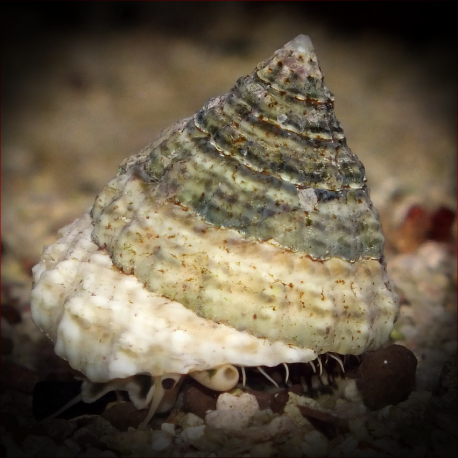More info
Datasheet
| Maximum Size | 6.3cm / 2.48inches |
| Reef Compatible | Yes |
| Temperament | Peaceful |
| Care Description | Easy |
| Specific Gravity | 1.023-1.025 |
| Carbonate Hardness | 8-12 |
| pH | 8.1-8.4 |
General Description
The Turban Snail, also known as the Top Snail, False Trochus Snail, or Pyramid Snail, is a marine invertebrate found in the Indo-Pacific Ocean. It features a uniquely shaped bumpy shell in earth tone colors such as white, tan, or brown, with a white foot adorned with fine black dots. This peaceful snail is a beneficial addition to aquariums as it helps control algae growth.
Aquarium Suitability
The Turban Snail is suitable for aquariums, particularly in established tanks with ample hiding spots and live rock. It requires a large grazing area and should be housed in an environment where the calcium levels are well-maintained. This species is sensitive to copper-based medications and thrives in low nitrate conditions.
Care and Hardiness
Considered easy to care for, the Turban Snail is a hardy species that can thrive in appropriate aquarium conditions. It is important to ensure that there is enough algae present for the snail to graze on. Supplementing their diet with dried seaweed is recommended if natural algae levels are insufficient.
Reef Suitability
Reef enthusiasts will find the Turban Snail a suitable addition to their setups, as it is compatible with reef environments. Its peaceful temperament makes it a good choice for reef tanks containing other marine life.
Aquarium Setup
When setting up an aquarium for Turban Snails, it is essential to provide hiding spots, ample grazing areas, and live rock for them to explore. Maintaining proper calcium levels and avoiding copper-based medications are crucial. Keeping nitrate levels low is also advised for optimal health.
Behaviour
Turban Snails are peaceful creatures that are most active during the night. They will venture out into the light during the day as they grow. When spawning in captivity, these snails will release gametes, causing temporary cloudiness in the water before tiny offspring appear.
Feeding and Diet
As herbivores, Turban Snails primarily feed on algae. In instances where natural algae levels are insufficient, their diet should be supplemented with dried seaweed. Ensuring a well-balanced diet is essential for their overall health.
Dimorphism and Captive Reproduction
In captivity, Turban Snails can reproduce, especially in mature reef aquariums. During spawning, the snails release gametes into the water, eventually leading to the appearance of tiny snails on the glass and substrate. Monitoring this process can offer insights into their reproductive behavior.
Habitat and Distribution
Naturally found in the Indo-Pacific Ocean, Turban Snails inhabit reef environments, where they seek out holes and crevices for shelter. Their distribution in the wild underscores their importance in maintaining ecological balance within their natural habitats.

